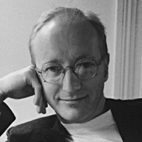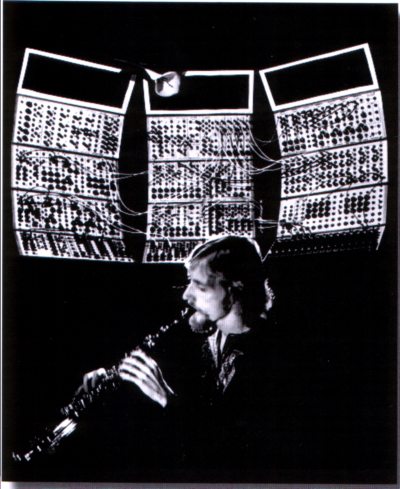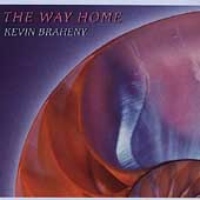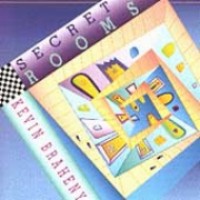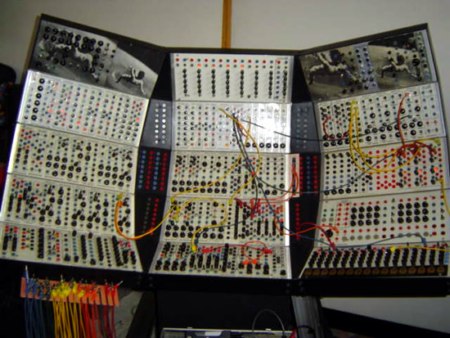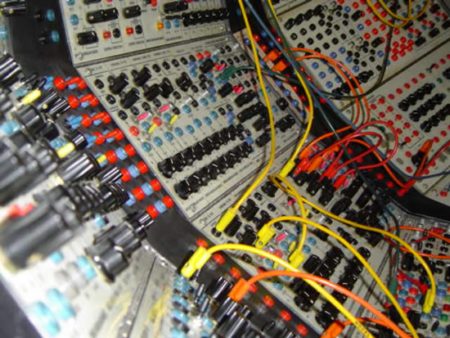|

Kevin, can you please tell something about your debut album “Lullaby For The Hearts of Space”?
Well, the album “Lullaby For The Hearts of Space” was a live album of mine. “Lullaby” was an improvisation recorded on live radio – “Music From The Hearts of Space”. I patched it up in about 30 minutes and then played. The other piece “After I Said Goodnight” was played live during one of Emilie Conrad’s classes (Emilie was choreographer and founder of Continuum Movement, classes for innovative movement; BS). I was ill that evening and Michael Stearns couldn’t fill in for me so I got there early and made all those crickets and jungle sounds, made a tape loop of my voice and some small bells, etc. When it came time to play, I had a high fever and the soprano sax solo in the middle of the piece expressed that. As soon as I finished playing that solo my fever broke and then I made the synthesizer sounds softer and cooler.
Michael (who had his own label then) and Stephen Hill encouraged me to start a label and put it out on cassette. I am in the process of restoring it and will put it out on a cd. It is an example of what can be done “live” on a large Serge synthesizer with no keyboard.

After that you made the classic albums “Galaxies” and “Perelandra”/“The Way Home”. Can you sketch some background on them?
I recorded the first version of “Perelandra” in early 1978. Stephen Hill played it very often in his “Music From The Hearts Of Space” radio program on KPFA in Berkeley, California. I had started my own record company in 1980 with the release of “Lullaby From The Hearts of Space”. He got so much response to “Perelandra” that he suggested I release it as an album. I didn’t get that happening soon enough for Stephen who said something like “Look, if you’re not going to put this out, I will.” That piece of music was the first release of Hearts of Space Records. He asked me if I had a piece for the B-side. I decided to compose a new piece that would go with “Perelandra” and it became “The Way Home.” I had just finished building the prototype of the EWI (Electronic Woodwind Instrument) designed by my friend Nyle Steiner and used it on “The Way Home.” I then added some things to “Perelandra” and remixed it and gave it to Stephen. That was in 1983 or ‘84.
In the meantime I had gotten more involved in the recording studio scene in L.A. I collaborated in the building of six studios, was a recording engineer/producer, session musician, and also a technical engineer/consultant for several studios. At the time, the Fairlight CMI (computer music instrument) was new. (A whopping half-second sample at 8 bits! Wow!) My good friend Gary Chang had become the product specialist for Fairlight. We built a studio called PMO (Producer’s Music Organization) that was the first studio that I know of that had the Fairlight and 24-track tape recorder (and the Mighty Serge) synced to video. We were a one-stop facility where composers and producers could work directly to video. Pretty cool at the time. Now, of course, we can do that at home with our DAW’s.
During that time I had access to the Fairlight for a few hours and recorded the opening to “The Way Home” and the ending on my 8-track recorder. (Those breathy, airy vocal sounds.) I had no idea what the middle would be. So having a limited amount of time with the instrument I recorded a series of musical “questions” with blank spaces in between. Then later I musically “answered” those questions with the EWI and my other instruments. “The Way Home” then became the opening track on “Perelandra” as it was a stronger opening piece and just seemed to fit better there. The graphics for “Perelandra” had already been set in motion so it remained the album title. When it was released on cd it became “The Way Home.”

I think it was in 1986 when I was approached by Timothy Ferris to compose the soundtrack for a planetarium show called “Galaxies.” Tim had written a very beautiful book of the same title that this show was based upon. Tim has been an educator and a science writer for many years. I was honoured to be a part of that project. I had about ten days to compose and record the whole show. I had no visuals, only a script. And the script kept changing so that meant the timing of the music kept changing. Today, with DAW time-stretching etc. it is a relatively simple matter to adjust. Back then, one had to re-do things and re-record. All part of the soundtrack composer’s job.

I recorded the tracks at Richard Burmer’s home studio on a one-inch 16 track. Steve Roach had introduced me to Richard and I really enjoyed working with him. Although a talented musician, he was functioning only as an engineer and Emu Emax programmer with an extensive repertoire of sampled sounds that he shared with me. He was very generous and supportive.
The show premiered at the Hansen Planetarium in Salt Lake City, Utah. I retained the rights to the soundtrack music and gave that to Hearts of Space as well.
Soundtrack music is meant to support and expand the visuals and the emotions. As a stand-alone piece of music it may be undeveloped musically but perfect in its simplicity for the intended scene. I hesitated somewhat in releasing it in its stand-alone undeveloped state, but finally I did. Sometimes simple is better. I transferred the tracks I did at Richard’s and did the final album mixing at Crystal Studios where I was engineering. I soon became chief engineer there.
And there was also the album “Secret Rooms”.
“Secret Rooms” was originally going to be titled something like “The Spirit House.” It was about what was happening to me at the time. I had Spirits speaking through me. Musically and then verbally. I became a trance-channel. A medium. These pieces of music were about these different spirits. I think it would have been strange to try to market something like that. So it became “Secret Rooms” where the rooms were actually the Spirits. I designed and built a binaural recording system with the help of my friend Prof. Keith O. Johnson who helped me with the preamp. I made it very tiny and portable. The microphone capsules fit into my own ears and I walked through different rooms and spaces recording onto a portable DAT recorder.

The shape of the room we’re in affects our thinking. For example, with your eyes closed you would probably have different thoughts in a small little closet than you would in a cathedral. We know the shape of the room by what it sounds like and feels like. The “Passages” on “Secret Rooms” were all recorded with this binaural system and it is also heard on “Things Seen and Unseen.” If you listen on headphones you’ll get the full 3-D effect. The first “Passage 1-Ingress” is me walking from my car, into the studio, down the hall, into the control room, and over to the Studer A-80 tape machine where I hit PLAY and then the first piece “Til You Get There” begins. After the last piece, “Hard To Say Goodbye” ends, we hear the tape running out and flapping on the take-up reel. I then walk back out the way I came, lock the door, and go back to the ocean of L.A. city sounds.
The album cover, unfortunately, did not match the feeling tone of the album. Also, there were two other pieces that were rejected by the record company, which I may release in some form, perhaps as archival music.
In that period you also kept contact with Richard Burmer. Did you two ever compose music together?
No, we never did, directly anyway. We did “tag-team” composing for one of the pieces on “Western Spaces.” Steve Roach did a couple of tracks on a ½ inch 8-track, gave the tape to me and I did some recording, and then Richard added his tracks. (I think that was the order.) We were never all in the same room until I mixed it at Richard’s. Richard moved to Michigan and, I’m sorry to say, I have not been in touch with him for a while.
How did you get to know Steve Roach? What’s there to tell about your collaborative album “Western Spaces” and “Desert Solitaire”?
I first met Steve at some kind of party in a big loft space in ’81 or ‘82. He was performing. He was doing a very techno style of music then. Kind of like Tangerine Dream. I met him again at an electronic music festival where we heard each other play. He approached me about collaborating. We did a few gigs together. One that stood out was playing live on radio. My style of playing at the time was textural and melodic on the instruments that I had built. “Structures From Silence” came directly out after what we did on the radio and it was different from what he had been doing up until then. I did the final mix for him.
Steve was really good at getting himself out there. I was not, so I appreciated that he would call me up and ask if I wanted to do this or that gig or play on an album. We did a piece called “The Other Side” which is on his “Dreamtime Return” album. He had hooked up with a new record label that wanted his music. Back then, this music that he and I, Eno, Harold Budd, Terry Riley, Stearns, and others were doing was new to the general public. We weren’t all doing the same kind of music but none of it was then currently commercial. It gained some popularity as time went on. It was still rather speculative for a label to invest in an artist of alternative music. The label that Steve connected with wanted to include other artists as well. He contacted me and Richard Burmer to join the project. That was “Western Spaces.” I did the mastering of that original album with Ken Perry.
With the success of that project we did something similar for “Desert Solitaire” only with Michael Stearns this time. I wasn’t involved in the mastering process for this album and consequently the piece, “Knowledge and Dust” was toned way down in the higher frequencies. I had recorded a real rattlesnake in the studio and the sound of it is mesmerizing. When I heard it on the final project it was missing that edge that was on my original recording. Oh well, these things happen.
After what seemed a period of silence, you composed two albums with Tim Clark, which both are rather new age like? How come?
The period of silence was that I became very ill. I was working on an album for Hearts of Space in ’92 that was nearly completed. Hearts changed their mind about this album and wanted something different. Many stressful things were happening in my life and the illness changed everything. I was standing on the roof of my studio during the L.A. riots hosing it down so it wouldn’t catch fire and I took it as an omen to move on. I packed up my studio and my life and moved up to the San Francisco Bay Area to heal from this illness. It took me over twelve years to do it. I needed to take a break from the public music scene for a while, or was forced to really.
I’ve had a parallel career in the healing arts since about 1977. I focused more on that during the “silent period” and I’m still active in that. I have been teaching Tantra privately and then in groups for about the last 18 years.

I was contacted to play for a healing conference in Arizona. Turned out that it was about ten minutes from Tim’s house. I called him and discovered we were both fans of each other’s music. We played the gig together and the musical connection was amazing. So we did “Rain”. Much of what we did on those two albums was live. We just sat down and came up with sounds that we liked, tuned into the theme of the album, and played. I love when that happens.
There are many different kinds of music that I’m interested in and have played. I started playing piano when I was a little kid and was classically trained on piano and woodwinds. I had been playing gigs since I was a teenager and worked my way through Music College. I played many different instruments so I got work playing in clubs, etc. (Sax, keyboards, guitar, electric and acoustic bass.) I played jazz, funk, R&B, gospel, rock, top 40, etc.
The music that Tim and I made is just what came out. I don’t identify with “New Age” as a type of music. I had been composing what was later to be called “space music” since the late sixties. I didn’t know that anyone else would be interested in it. I was very interested in electronic music but couldn’t afford the gear until I bought an EML 101 in 1972. (I used it to play the flute melodies in “Perelandra” even after I had built the Serge but before the EWI.)
I’ve written symphonic music since I was 17 or 18 but couldn’t afford to get an orchestra to play it so that I could hear it outside of my own head. I had to build my own electronic orchestra to do it. It opened up a rich new palette of sound possibilities. Although I could do it, I was less interested in trying to make synthesizers sound like familiar instruments than in exploring and creating new “instruments” and landscapes. Like the soundtrack for perceiving the world in a new way.
There also was a rumour on www.emforum.nl a while ago that Michael Stearns did use his own Serge Modular for recording “Planetary Unfolding” after he tried yours first…. Is this correct, or is there a different story behind this?
To answer that question I’ll go back a bit. In 1975 I met Serge Tcherepnin through Malcolm Cecil who I was working with. Malcolm had produced 4 of Stevie Wonder’s albums and had built and instrument called T.O.N.T.O. – The Original New Timbral Orchestra- a large hybrid Moog/Arp/EMS system. I was playing music with him and also maintaining and adding to his system as per his design. He asked Serge to design and build an oscillator that would stay in tune and be temperature stable. That had not been successfully accomplished up until that time. It became the NTO: New Timbral Oscillator. I then began building Serge’s synthesizers and helped him get his company into higher production.

In 1977, I was introduced to Emilie Conrad who was the founder of Continuum Movement. I began to play live music for her innovative movement classes. I was there for 4 years. That is how I met Michael Stearns. He was already playing there. At the time, Michael’s musical approach mostly was to montage things that were already around. Field recordings of natural sounds mixed with some musical elements. He was working on an album I liked called “Ancient Leaves”. I know he’d used a little Mini Moog on it but he didn’t know how to use it yet.
I had been building my own highly customized Serge Modular later dubbed “The Mighty Serge”. I brought it to Continuum and began playing it “live” for the movement classes and events. No keyboard. Michael was enthralled by its capability and wanted to learn. He knew nothing about synthesizers at the time. I gave him lessons and let him use my instrument. He would also use it when I wasn’t there and sometimes “borrowed” patches that I was working on for my own music and alter them slightly by changing the tuning, etc. The synthesizer sounds on “Planetary Unfolding” came directly from what he had learned from me. Some of it may have been “borrowed ” from my instrument as he was working on that album before he got his own Serge. I had built a Serge for Craig Huxley that he sold to Michael. So, the answer is, I don’t know how much of what Michael used came from my instrument and how much came from his as I wasn’t around when he did it. The patches he used, however, were ones that he learned or borrowed from me.It’s a nice album and Michael has continued to develop his talent for creating really beautiful, evocative, stereo landscapes.

Will there be any new music released by you besides the already mentioned restored version of “Lullaby”? Are you interested / available for any new collaborations?
I have hundreds of unreleased pieces of music in different genres. Many hundreds. I’m going through them and restoring some of the earlier works. I’m not sure in what form they will be available but I’m working on it. The album “Passion’s Dance” that I did in ’92 right before I got sick is also being finished. I’m doing new music all the time and will keep you informed of new releases.
I am available for collaborations if the musical and creative possibilities interest me. I like the “creative conversation” aspect of it.
Note December 2007: The re-release of “Lullaby…” is taking some time. The original tape was lost and all other copies have disintegrated. So Kevin is painstakingly restoring the music from several tapes. It’s coming along but it’s going a few seconds at a time. “Goodnight is in much better condition so the real work is with “Lullaby.” There’s still no date when it will be available but Kevin is committed to restoring it.
Discography:
Lullaby for the Hearts of Space (1980)
The Way Home (1984)
Western Spaces (1987)(with Steve Roach & Richard Burmer)
Galaxies (1988)
Desert Solitaire (1989)(with Steve Roach & Michael Stearns)
Secret Rooms (1990)
Rain (1995)(with Tim Clark)
The Spell (1996)(with Tim Clark) |
